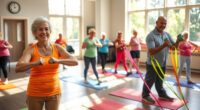Senior yoga classes are designed to boost flexibility and promote peace of mind through gentle movements and mindful breathing. You’ll enhance your balance, strengthen joints, and experience less chronic pain. The classes create a comfortable space with support props to help you feel at ease. Engaging in mindful changes and participating in a community of fellow seniors fosters connection and camaraderie. Discover how these practices can transform your well-being and enhance your yoga journey.
Key Takeaways
- Gentle yoga poses enhance flexibility through seated and standing practices, promoting better mobility and reducing stiffness in seniors.
- Breath awareness techniques foster relaxation, improve mental clarity, and strengthen the mind-body connection for overall well-being.
- Incorporating props like cushions and blankets supports safe movement, enhances comfort, and encourages deeper stretches during practice.
- Building a community through group sessions combats loneliness, fosters friendships, and provides motivational support among seniors.
- Mindful movements cultivate present-moment awareness, promoting emotional regulation and inner peace throughout the yoga experience.
The Importance of Gentle Movement for Seniors

As you age, incorporating gentle movement into your routine becomes essential for maintaining overall health and well-being. Practices like yoga not only enhance flexibility but also promote joint mobility, reducing stiffness and improving overall physical function. By engaging in gentle movement, you lower your risk of falls, as it boosts balance, coordination, and strength. When you roll out your yoga mat, remember to listen to your body; safe stretching can alleviate chronic pain conditions, such as arthritis. Additionally, these movements foster better body awareness and mindfulness, helping to reduce stress and anxiety. Regular gentle movement even supports cardiovascular health, contributing to better heart health and circulation as you continue to embrace an active lifestyle. Furthermore, participating in community events can further enhance your social connections and overall well-being, helping to build positive relationships that are crucial for emotional support as you navigate life changes. Engaging in personalized learning can also deepen your understanding of yoga practices tailored to your individual needs. Moreover, incorporating gentle movement into your routine may also improve cognitive function, which is vital for maintaining independence in later life. Engaging in regular activity, such as proper diet and exercise, can significantly enhance your physical and mental health.
Creating a Comfortable Practice Space
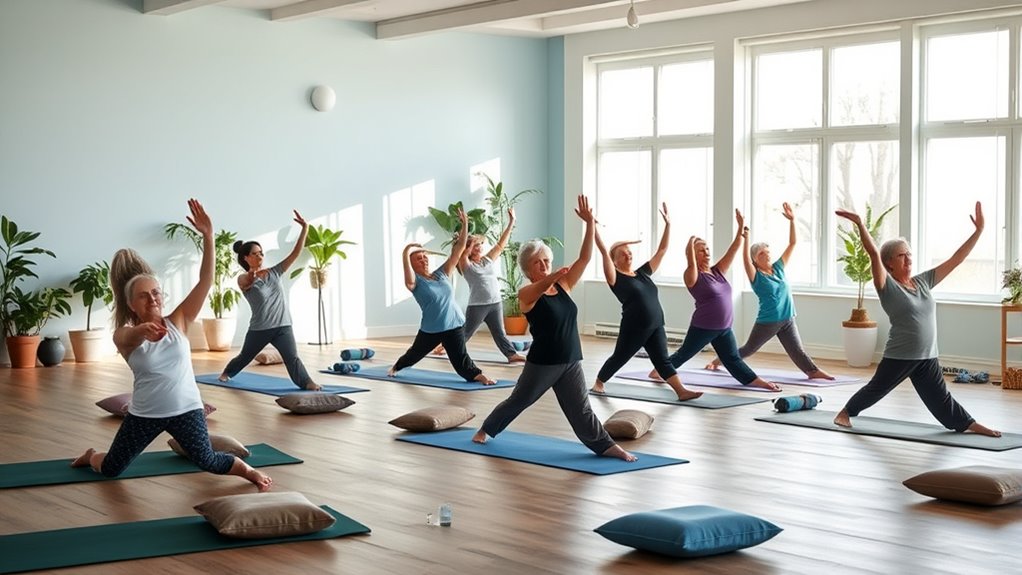
Creating a comfortable practice space is essential for enhancing your yoga experience, especially as you age. Start by choosing a quiet, well-ventilated area free from distractions.
Make certain you have enough room to move freely, allowing for gentle movements without feeling cramped. Incorporate props like blankets and cushions to support your back and joints, providing extra comfort during every step of your practice. Additionally, AI-powered virtual reality can enhance immersive experiences for those interested in exploring yoga in a new way. Engaging with multimedia formats can further improve your understanding of different yoga techniques. Adding a high-quality air purifier can also improve your practice environment by ensuring you breathe clean air, which is beneficial for your overall health and relaxation. Air purifiers can effectively reduce allergens and odors, promoting a healthier space for your yoga sessions.
Soft lighting and calming decor, such as plants or soothing colors, can help create a serene atmosphere.
Finally, make certain you have a non-slip surface, like a yoga mat, to prevent slips and falls, keeping you safe as you explore your yoga journey. Additionally, consider using cat furniture or pads to create a distraction-free environment, ensuring your focus remains on your practice.
Your practice space sets the tone for relaxation and peace of mind.
Breath Awareness: The Foundation of Yoga

Breath awareness is key to revealing the full benefits of your yoga practice.
By focusing on your breath, you enhance your mind-body connection and create a more intentional experience. This conscious breathing not only promotes relaxation but also sets the tone for a meaningful session. Additionally, incorporating mindfulness through unplugging from technology can deepen your connection with the present moment and enrich your practice. Practicing yoga can also help alleviate stress-related symptoms, such as ear pressure that may arise from tension and anxiety in daily life. Furthermore, engaging in nighttime meditation can complement your yoga routine by further enhancing relaxation and mental clarity. Moreover, cultivating emotional regulation through yoga may provide additional tools for managing stress and improving overall well-being. Regularly practicing stress management techniques can further enhance your emotional resilience during challenging times.
Importance of Conscious Breathing
While many elements contribute to a fulfilling yoga practice, conscious breathing stands out as an essential foundation. It promotes relaxation, reduces stress, and enhances your overall well-being. Studies have shown that engaging in conscious breathing can significantly improve mental clarity and emotional stability, especially among seniors. Regular practice of deep breathing is also linked to improved indoor air quality, which can further benefit your health and wellness. Additionally, incorporating effective relaxation techniques such as progressive muscle relaxation can enhance the benefits of conscious breathing.
By engaging in full, deep breaths, you activate your parasympathetic nervous system, which can lower your heart rate and blood pressure—especially beneficial for seniors. As you become aware of your breath patterns, you can adjust them, improving lung capacity and respiratory function, which is important for maintaining a healthy lower back. Engaging in positive thinking can further enhance your yoga practice and overall mental well-being.
Mindful breathing techniques also help you cultivate presence and clarity, leading to better mental focus and emotional stability. With consistent practice, conscious breathing empowers you to embrace movement with greater ease, encouraging you to come back to your mat confidently. Additionally, integrating self-reflection techniques into your practice can further enhance your mindfulness and overall growth.
Enhancing Mind-Body Connection
To truly enhance the mind-body connection in your yoga practice, embracing breath awareness is key. When you focus on your breath, you create a bridge between your thoughts and physical sensations, helping you tune into your emotions and body.
This conscious breathing can lead to profound benefits, especially for seniors seeking peace of mind.
- Feel the calming embrace of each breath.
- Experience a deeper sense of relaxation.
- Discover improved lung capacity and liveliness.
- Cultivate a present-moment awareness that sharpens clarity.
- Enhance your ability to recognize and respect your physical limits.
Additionally, participating in spiritual retreats can further complement your yoga journey by providing a serene environment conducive to mindfulness and healing.
Setting Intentions for Practice
Embracing breath awareness not only enhances your mind-body connection but also sets the stage for intentional practice in yoga.
By focusing on your breath, you cultivate mindfulness, allowing you to align your movements with personal goals and intentions. This enhances your clarity and focus, fostering a deeper connection to your practice.
As you breathe consciously, you promote relaxation and reduce stress, which is especially beneficial for seniors. Setting intentions provides a framework for your session, guiding your practice toward personal growth and self-acceptance.
Engaging in breath awareness also soothes your nervous system, encouraging a natural flow of movement that enhances body awareness and the effectiveness of gentle yoga poses.
This leads to improved flexibility and a sense of mental peace.
Seated Poses for Enhanced Flexibility
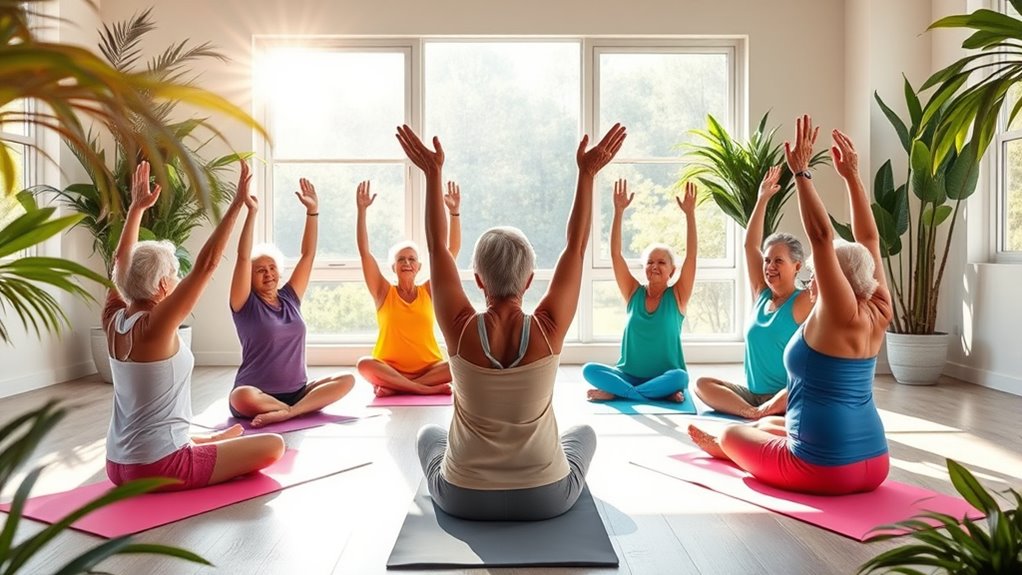
Seated poses in yoga offer a wonderful way to enhance flexibility, especially for seniors looking to maintain mobility in their spine and hips.
You can practice seated forward bends and gentle twists to promote circulation and reduce stiffness, making everyday movements easier. Incorporating breathing techniques not only increases lung capacity but also encourages relaxation, allowing you to access deeper stretches.
Regularly practicing these poses enhances body awareness and balance, which can help prevent falls.
- Feel the gentle release of tension in your body.
- Experience increased mobility in your daily life.
- Enjoy a deeper connection with your breath.
- Discover a sense of peace and stability.
- Cultivate a joyful appreciation for your body’s capabilities.
Incorporating Props for Added Comfort
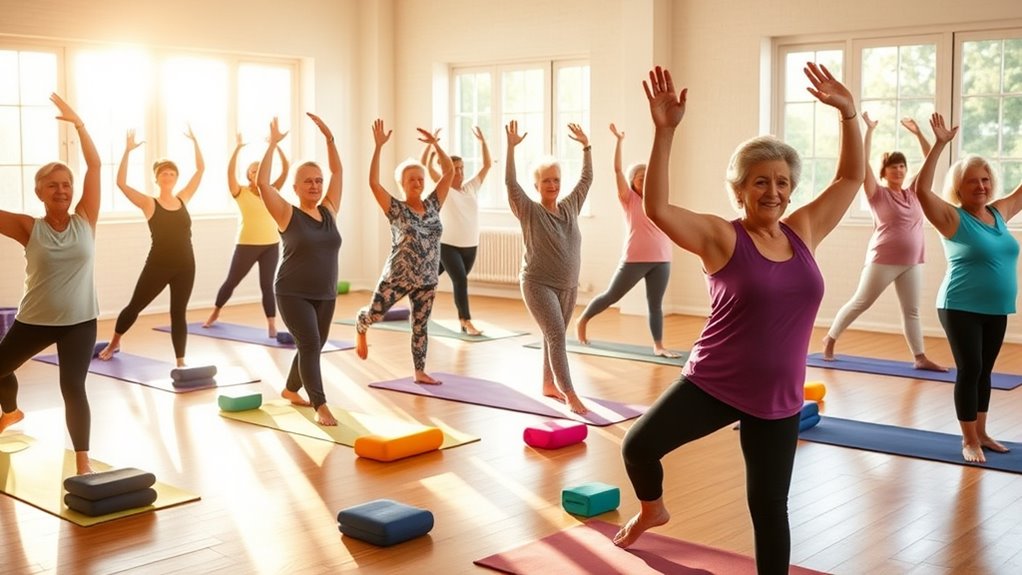
Incorporating props in your yoga practice can considerably enhance your comfort and support.
From blankets to blocks, these tools help you maintain proper alignment while making poses more accessible.
Let’s explore the benefits of using props, the types that can be beneficial, and tips for effective use to elevate your yoga experience.
Benefits of Using Props
While many seniors may hesitate to try yoga due to concerns about flexibility or balance, using props can greatly enhance their practice. Props like blankets, towels, or blocks provide essential support, allowing you to maintain proper alignment and reduce strain in poses.
They boost your stability and confidence, helping you tackle movements that might seem intimidating. By elevating your body with props, you can achieve deeper stretches and improve overall mobility. Plus, they cushion sensitive areas, minimizing the risk of injury during ground work.
- Experience increased comfort in your practice
- Feel more secure and balanced
- Enjoy deeper, more fulfilling stretches
- Personalize poses to fit your needs
- Foster a sustainable and enjoyable yoga routine
Types of Useful Props
Using props can greatly enhance your comfort and accessibility in yoga practice.
Yoga blocks, straps, and bolsters provide essential support and stability, making poses more manageable if you have limited flexibility or mobility.
Blankets or towels can add cushioning during seated or kneeling positions, reducing strain on your joints.
Incorporating chairs into your practice lets you perform various poses safely while maintaining balance.
Eye pillows or soft cloths promote relaxation during restorative poses, creating a serene environment for mindful practice.
Additionally, using wall space helps you maintain alignment and balance, allowing you to explore standing poses and stretches without the worry of falling.
Embrace these props to enjoy a more comfortable and effective yoga experience.
Tips for Effective Use
To enhance your yoga practice with props, start by selecting the right tools that cater to your needs. Incorporating props can transform your experience, making it more enjoyable and accessible.
Here are some tips to maximize their effectiveness:
- Use blankets or cushions for extra comfort and support in seated positions.
- Elevate your hips to relieve lower back pressure and improve hip flexibility.
- Incorporate a chair for safe standing poses, boosting your confidence while moving gently.
- Utilize yoga blocks to help you reach poses without straining, ensuring safety.
- Integrate props regularly to create a relaxing environment, fostering mindfulness and ease in your practice.
Embrace these tools to enhance your journey toward flexibility and peace of mind.
Standing Poses to Build Strength and Balance

Standing poses are vital for building strength and balance, as they actively engage your core and lower body muscles while promoting proper alignment.
Poses like Triangle and Mountain help you develop stability, enhancing your posture. When you incorporate gentle twists into your standing sequences, you boost spinal mobility and balance, which is essential for maintaining independence.
Holding these poses longer improves muscle endurance and joint stability, reducing your risk of falls. Additionally, practicing standing poses regularly increases flexibility in your hips and legs, making everyday movements easier.
Remember to focus on your breath during these poses; it fosters calmness and clarity, enhancing your mental peace. By integrating these practices, you can greatly improve both your physical and mental well-being.
Mindful Transitions Between Poses

As you progress through your yoga practice, shifting between poses with intention can greatly enhance your experience.
Mindful movements allow you to connect with your body and breath, fostering a sense of calm. By moving slowly and deliberately, you reduce the risk of injury while maintaining proper alignment.
Mindful movement fosters a deep connection with your body and breath, promoting calmness and enhancing alignment while minimizing injury risk.
Using props like blankets or cushions can provide comfort and support, making movements smoother.
- Feel the gentle flow of your body in motion.
- Experience the relaxation that comes with each breath.
- Embrace the peace that arises from mindful awareness.
- Discover the joy of gradual adaptation and flexibility.
- Cultivate a deeper connection with yourself and your practice.
These elements create a transformative practice that nurtures both body and mind.
The Benefits of Spinal Twists
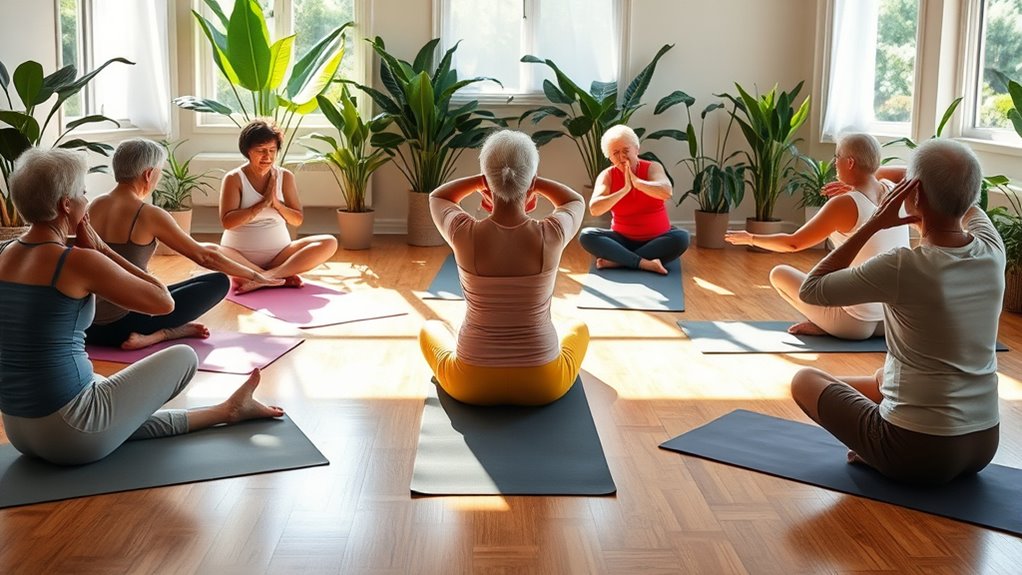
Spinal twists offer a rejuvenating way to enhance flexibility and relieve tension in your body. By incorporating these movements into your routine, you can increase spinal mobility, alleviating stiffness and improving your overall range of motion. This is especially beneficial as you age.
Spinal twists also promote better digestion, massaging your abdominal organs and boosting circulation for improved digestive health. Additionally, they relieve tension in your back and shoulders, helping you feel more relaxed.
You’ll find that twists stimulate your nervous system and improve your posture, encouraging proper spinal alignment essential for maintaining balance. Regularly practicing spinal twists not only enhances your physical well-being but also fosters body awareness, contributing to your mental clarity and peace of mind.
Cultivating Mindfulness Through Yoga

In your yoga practice, focusing on breath awareness can transform your experience, helping you stay present and connected.
Gentle movement techniques and mindful shifts allow you to cultivate a deeper awareness of your body, enhancing relaxation and inner peace.
As you explore these elements, you’ll find that mindfulness enriches not just your yoga sessions, but your daily life as well.
Breath Awareness Practices
Breath awareness practices form the foundation of mindfulness in yoga, inviting you to observe and adjust your breath intentionally.
By focusing on full, deep breaths, you foster a sense of calm and presence. Setting a personal intention at the beginning of your session aligns your breath with your goals, enhancing the mindfulness experience.
As you observe your breath, you might notice physical relief in your back body while also cultivating mental clarity and emotional stability. Regular practice can lead to improved lung capacity and overall respiratory health, contributing to your wellness and peace of mind.
- Feel the soothing rhythm of your breath.
- Embrace the calm that fills your mind.
- Discover clarity in each inhale and exhale.
- Release tension with every deep breath.
- Connect deeper with your body and spirit.
Gentle Movement Techniques
Gentle movement techniques in yoga offer a nurturing way to cultivate mindfulness and enhance physical well-being. Practices like seated twists and arm reaches promote flexibility and spinal mobility, which are essential for your health.
Focusing on breath awareness during these movements encourages relaxation and mindfulness, allowing you to connect with each pose. Utilizing props like blankets or cushions adds comfort, making it easier to engage without strain.
Consistent practice of these gentle movements helps reduce tension and fosters a sense of calm, improving your mental well-being. Additionally, mindful movements enhance body awareness and alignment, which can boost your overall balance and lower the risk of falls.
Embrace these techniques to support both your body and mind.
Mindful Transitions in Yoga
Building on the foundation of gentle movement techniques, mindful shifts in yoga encourage a deeper connection to your body and breath.
By intentionally focusing on changes, you enhance your body awareness and alignment, which is especially beneficial as you age. Practicing slow, deliberate movements allows you to center yourself, reducing stress and fostering mindfulness.
Gentle changes, like moving from seated to standing, promote relaxation and minimize injury risk.
Consider these emotional benefits:
- Feel a sense of calm wash over you with each mindful movement.
- Experience increased confidence in your body’s capabilities.
- Embrace the present moment, letting go of distractions.
- Discover fluidity in your practice, enhancing joy.
- Cultivate inner peace as you flow through your poses.
Building a Community in Senior Yoga Classes
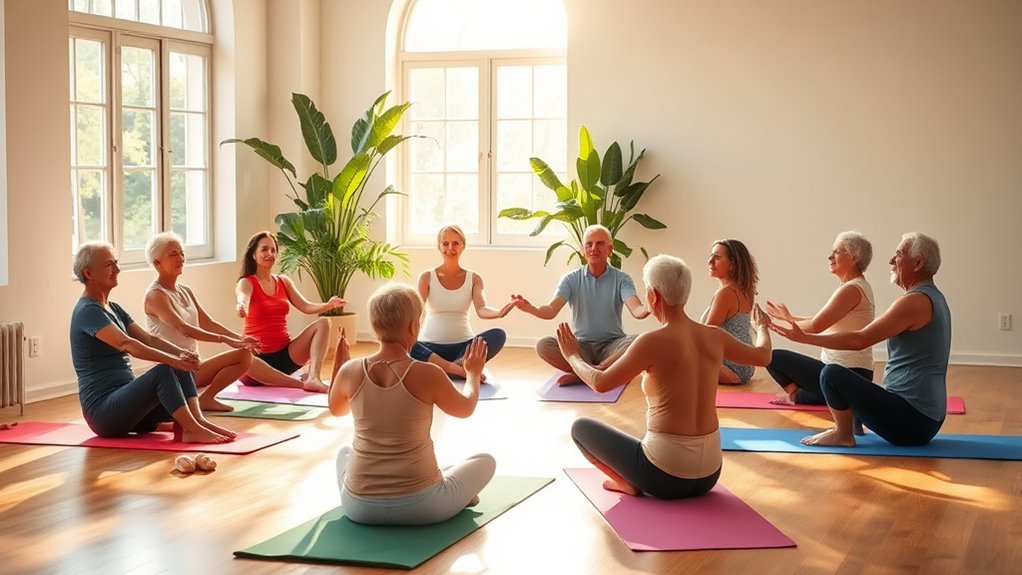
Creating a strong sense of community in senior yoga classes can greatly enhance the experience for participants. When you engage with others in group sessions, you foster social connections that help combat feelings of loneliness and isolation.
These shared experiences promote camaraderie and provide mutual support, boosting your overall mental well-being. Regular attendance allows friendships to blossom, creating a supportive network that encourages you to stay committed to your practice.
Shared experiences in yoga foster camaraderie and support, enhancing mental well-being and nurturing lasting friendships that keep you committed to your practice.
This community engagement not only enhances motivation but also holds you accountable, as you inspire one another on your wellness journeys. Plus, group classes offer opportunities for shared learning and feedback, making you feel more connected and empowered in your yoga practice.
Embrace this community; it’s an essential part of your journey.
Frequently Asked Questions
Which Type of Yoga Is Best for Seniors?
When considering which type of yoga is best for seniors, you’ll find that gentle styles like Hatha and Yin are ideal. They emphasize slow movements and breath awareness, making them safe and accessible.
If mobility’s a concern, chair yoga lets you stretch while seated. Restorative yoga promotes relaxation, while therapeutic yoga addresses specific health needs.
Look for classes that focus on balance, as maintaining stability is essential for independence as you age.
Is 70 Too Old to Start Yoga?
Is 70 too old to start yoga? Absolutely not! You can embrace this journey at any age, discovering newfound flexibility and strength.
While some might think it’s too late, many seniors find joy and relief through gentle practices. You’ll improve balance and reduce stress, all while fostering a deeper connection with your body.
How Many Times a Week Should Seniors Do Yoga?
You should aim to practice yoga 2-3 times a week to see improvements in flexibility and balance.
If you can, try to incorporate daily sessions, even if they’re just 20-30 minutes long. Consistency is key, so find a routine that feels right for you.
Always listen to your body and adjust your practice based on how you feel. If you’re uncertain, consulting with your healthcare provider can help guide your yoga journey.
Which Is Better for Seniors, Pilates or Yoga?
When pondering the timeless debate between Pilates and yoga, think of ancient philosophies that prioritize balance and strength.
For seniors, yoga often shines due to its emphasis on flexibility, breath awareness, and relaxation, which can enhance both physical and mental well-being.
However, Pilates isn’t to be overlooked, as it builds core strength essential for daily activities.
Ultimately, it’s about your personal goals and preferences; integrating both can yield the best results.
Conclusion
Incorporating yoga into your routine can transform your life, opening doors to flexibility and serenity you never thought possible. By embracing gentle movements and mindful practices, you’ll not only feel physically better but also cultivate a sense of peace that radiates from within. So gather your friends and join a senior yoga class—it’s like finding a treasure chest of joy and connection! Start today, and watch as your body and mind blossom in ways you never imagined.

